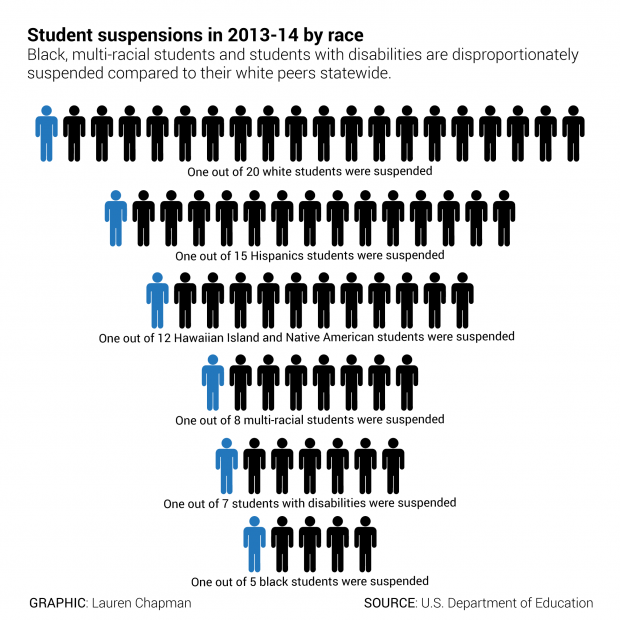Reporter’s Notebook: Covering Race, Suspension and Bias In 2016

Data from the Department of Education provides a snapshot of civl rights in U.S. schools. Indiana schools use suspension more often than most of the nation’s schools. (Eric Castro/Flickr)
I’ll admit it, I’m a bit of a nerd.
Yes, I like math. Yes, I like digging through data sets. So when the U.S. Department of Education released the largest data set it ever compiled on civil rights in schools, unsurprisingly, I was pumped.
I cracked my knuckles and excitedly dove into the Civil Rights Data Collection. This report breaks down civil rights data for every public school and school district in the country. (Full disclosure: the file was actually so big my computer actually crashed on the initial download)
And Indiana’s data is not great. Indiana schools suspend more students than most.
Hoosier students with disabilities and students of color accumulated 75,000 suspensions in 2014. And while black students make up about 12 percent of statewide enrollment, they make up 34 percent of the total suspensions. More than 1 in 4 black boys are suspended from Indiana schools.
Many suspensions can be for non-violent, non-drug related incidents. Situations that require a judgment call.
“We see the greatest disparities in those categories, like defiance and non-compliance,” Russ Skiba, director of the Equity Project at Indiana University, told us in June.
So I set out to find schools and teachers working to combat these racial disparities and I met Ayana Coles.
Coles, a third grade teacher at Eagle Creek Elementary School in Indianapolis’ Pike Township, was gathering her colleagues after school for open, honest conversations about race. Her goal? Generate conversation about race and power, with the hope that teachers acknowledge and address the ways race plays out in the classroom.
These informal sessions, led by Coles, could get raw. As I sat through one, teachers frankly stood up and said they were raised not to trust black people. Or not to trust white people. And that they felt like this got in the way of relating to their students.
It was a judgment free zone where teachers listened, learned and offered advice.

Ayana Coles sits with her students at Eagle Creek Elementary School. At Eagle Creek, students of color make up 77 percent of the student body. Yet, all but four of the school’s 37 staff members are white. Coles led conversations about race with colleagues throughout the year. (Peter Balonon-Rosen/Indiana Public Broadcasting)”
Teachers I spoke with at Eagle Creek said the sessions challenged their beliefs and made them think about how their preconceived notions impact their students’ lives.
“Like what I think is misbehavior,” said Jason Coons, the Eagle Creek music teacher. “I’m not trying to sound like some hippie or something, but like, OK, is this really actually something that needs to be addressed or is this just, because it’s so different from what I grew up with, that I view this as offensive?”
Coles has been recognized for her work. Her principal adopted the sessions into teacher training. The state board of education pointed to this work as one of the state’s most promising teaching practices.
And Coles has similar conversations with her third grade students, too. I asked her who’s easier to have these conversations with: Staff or students?
“Kids, absolutely the kids,” Coles said. “Because they’re honest, they’re just like, ‘This is what I think, so this is what I’m going to say.’”
And Coles’ students that I spoke with, like 9-year-old Lynae Gude, said those discussions helped them think about the world differently.
“You can have power for any perspective that you have,” she says. “Like if you look at the world and you see negativity, you can be an advocate and say something about it.”
Check out the full story here.

